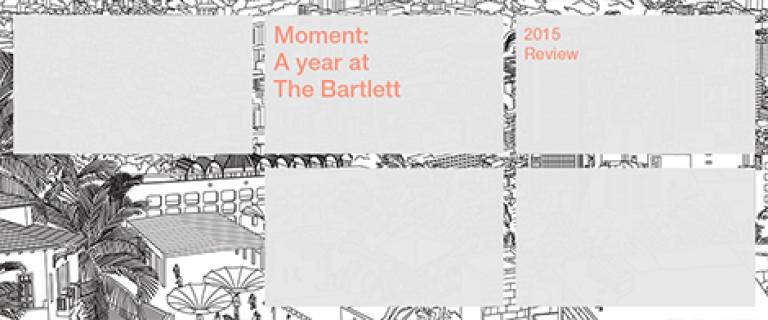Moment: A year at The Bartlett 2014/2015
28 October 2015

The Bartlett Annual Review: A personal message from our Dean, Alan Penn
View or download the complete publication 'Moment: A year at The Bartlett' (pdf)
Organisations above a certain scale face the question of how much can be planned, and to what degree management, at its best, must remain reactive. In order to work responsively, planning is all-important.
For The Bartlett growth has been planned. We are a comprehensive faculty of the built environment – one of only a few to be able to make this claim in the UK at present – and so we have aimed to ensure that each of our disciplines has the critical mass required to perform at a world leading level in education, enterprise and research. We have aimed to build the volume of our funded research in line with leading institutions in our field. We have worked to professionalise our administration and management to ensure that academic staff can focus on those aspects that require academic expertise and judgement, and have increased the proportion of professional services to academic staff.
We have also had to become more responsive because UK universities have made the transition from public-sector organisations to operating in a market. The quid pro quo for giving students direct access to the loan book was that individual students should be free to take their loans where they will.
We have recognised that as student fees increase, so too do expectations. At the same time, pressure on staff not only to teach, but also to engage in research and enterprise, all at the top ‘world-leading’ level, require both time to think, and space in which to do so. We have therefore worked to reduce student-staff ratios to best in sector levels, and to improve both the quality and extent of our estate. Meanwhile our turnover has nearly quadrupled. The whole faculty has become more efficient, more effective and more productive.
One measure of productivity is the Research Excellence Framework, the national evaluation of research in all UK universities, in all subject disciplines. On ‘research power’, a measure of the proportion of our staff assessed to be at the top 4* and 3* ranking, UCL outperformed both Oxford and Cambridge. The Bartlett also took pole position. In fact we submitted more staff whose research was rated at the highest level than the next three institutions in the league combined. Over 30% of those were early career researchers, something that bodes well for the future.
In terms of education, we have again topped the league tables for the built environment, and architecture: the Guardian and the AJ employer survey of the best UK school of architecture. Meanwhile the international QS league places us second in the world to MIT. Perhaps most pleasing is a top place for UCL in LinkedIn’s list of ‘Design Schools’. This is a carefully calculated league table based on which employers LinkedIn members who include ‘design’ in their job description work for, and from which university those employers recruit their design staff. UCL is truly a world-leading producer of design talent in Engineering and Computing as well as Architecture, Planning and Construction disciplines.
All of this raises a question around the limits to growth. To put it simply, small can be beautiful, but at the same time it can risk becoming limiting; scale allows diversity, and can offer efficiencies in administration. What is most important is that the structure of an organisation fits its driving logic.
In the case of The Bartlett, scale allows us plurality. Different viewpoints can be taken on any issue, creating the conditions for critical debate. It affords efficiency in administration while allowing a portfolio of activity to be balanced, helping manage the risks inherent to different funding streams and economic cycles. The real benefits come if the parts, which tend to specialise in particular viewpoints or methods, can come together around projects or programmes. With this in mind last year we restructured to create three new Institutes: the Institutes of Sustainable Heritage, and Environmental Design and Engineering join the Institute of Sustainable Resources and the UCL Energy Institute in the newly formed Bartlett School of Environment, Energy and Resources (BSEER) at Central House, while the UCL Institute of Global Prosperity has been established in new accommodation in Maple House.
In the last year we moved The Bartlett School of Planning and the Library to join BSEER in Central House, and The Bartlett School of Architecture and the Space Syntax Laboratory into temporary space in Hampstead Road. These moves make way for the major rebuild, retrofit and extension of 22 Gordon Street (formerly Wates House), which after 40 years was desperately needed. The project is due to complete in time for the 2016-17 academic year.
Even more exciting perhaps are our plans to take on a new ‘big space’ at the Here East development near Hackney Wick in early 2017, together with UCL Engineering. Here East offers a great opportunity for The Bartlett to lay the groundwork for UCL’s future presence in this emerging creative centre. The new spaces will allow us and our partners to bring groundbreaking research in architecture, infrastructure, transport, robotics, healthcare, manufacturing to East London and its surrounding communities, and in turn become a site for innovation on the national and international stage.
Image credit: RUA Arquitetos and MAS Urban Design, ETH Zurich
 Close
Close

